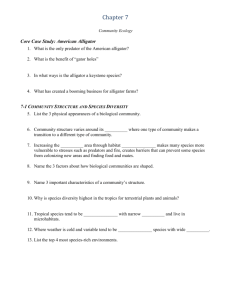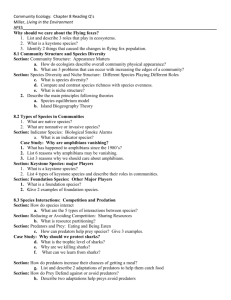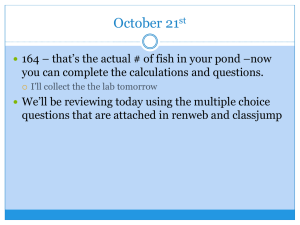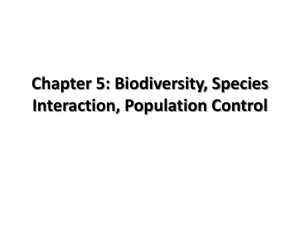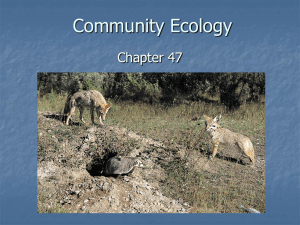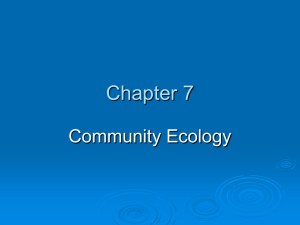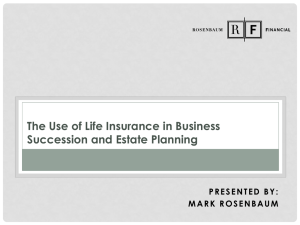Communities notes Bio1 2013
advertisement
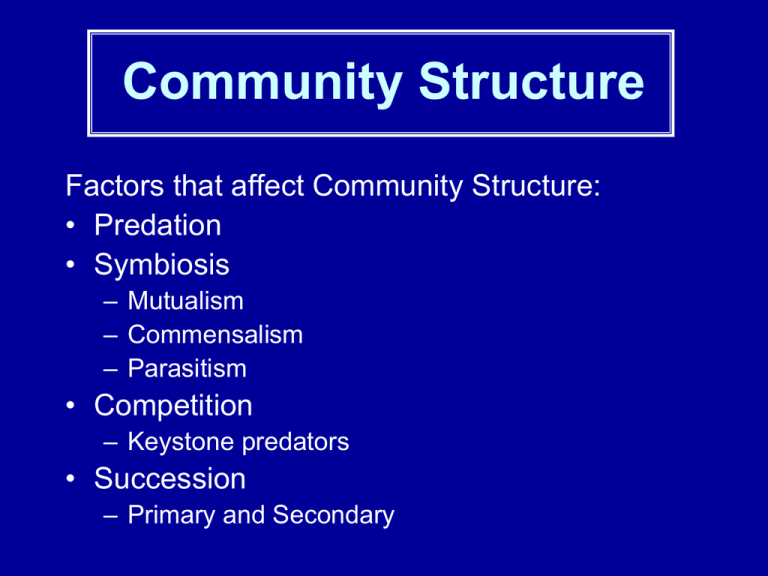
Community Structure Factors that affect Community Structure: • Predation • Symbiosis – Mutualism – Commensalism – Parasitism • Competition – Keystone predators • Succession – Primary and Secondary Predation • Predators feed on other living organisms -- their prey • Predators do not take up residence in or on prey (unlike parasites) • Prey may or may not die from relationship Symbiosis • A symbiotic relationship is one in which there is an intimate, long-term relationship between two (or more) species – Involves one species living on or in another species for at least part of life cycle • A symbiotic relationship could be: – Mutualistic – Commensalistic – Parasitic Mutualism • Mutualism is a symbiotic relationship in which both species _benefit . Above: Impala being “groomed” by Oxpecker bird, which gets a meal of insects. Left: Lichen is really a mutualistic symbiosis between photosynthetic algae (which makes sugars for both species) and a fungus, which “houses” the algae and protects it from water loss. Above & Below: A Clown fish makes its home and hides from its predators in an anemone and in return keeps the anemone clean from parasites and safe from its predators. Commensalism • Commensalism is a symbiotic relationship in which one species benefits and the other Above: Remoras get a free ride from a Lemon shark, but do no harm to the shark. species is not affected Below: Man-O-War fish (Nomeidae) find shelter and safety among the tentacles of a Portuguese Man-OWar jellyfish. Right: Epiphytes are plants that live on tropical tree limbs and obtain sunlight & rainwater without harming their “home” since their roots remain in the air (not inside tree bark or tissue). Parasitism • Parasitism is a symbiotic relationship in which one species benefits (parasite) and the other species is harmed (host). Left: Tapeworms inhabit animal digestive tracts, living off of the nutrients that are intended for the host. Over time, this weakens and can kill the host. Right: Ergot is a fungus that grows on grains such as barley, breaking down the grain and getting food from it. Above: Cowbirds are “brood parasites” they lay their eggs in another bird’s nest and leave them to be hatched & raised by the host species. Cowbird nestlings grow rapidly, frequently out-competing the host's offspring for food and parental care. This adult Yellow-throat is feeding a cowbird fledgling that's more than twice its size. Competition • Competition occurs when two or more individuals attempt to use an essential common resource that is in limited supply (food, water, shelter, sunlight, etc.) • Can be intraspecific (among individuals in a population) or interspecific (between different species) Ex) Oak trees and pine trees may compete for sunlight and space in a New England forest. Species - Species Interactions Interaction Direct Direct Effect on Effect on Species 1 Species 2 Neutral relationship 0 0 Predation of Sp2 by Sp1 + - Mutualism of Sp1 & Sp2 * + + Commensalism of Sp1 w/ Sp2 * + 0 Parasitism by Sp1 on Sp2 * + - Competition betw. Sp1 & Sp2 - - * Symbiotic relationship “Ancient Farmers of the Amazon” video clip • • • • • Leaf cutter ants Leaves (from trees) Cultivated Fungus (Ant “garden”) Mold Bacteria -- that produce “antibiotic” chemicals (really anti-mold) Competition & the Niche • Every org. has its own ecological role or “job” in its community; this is called its ecological niche. • This role description includes all the biotic & abiotic aspects of the organism’s existence; it’s physical habitat, it’s prey, it’s predators, it’s competitors, and how it is influenced by light, wind, water, etc. • When resources are abundant, different species can share a niche or role. Unlimited resources are not often found in mature, stable communities, however… Inter-specific Competition • More typically, species compete for resources and a particular niche. • Inter-specific competition between species with overlapping niches can lead to competitive exclusion. (ie removal of the less-fit species from the shared niche in question…) Competitive Exclusion Laboratory Experiment by Gause (1934): Two species of paramecium reach high population densities in given conditions when grown separately. When grown under the same conditions together, however, one species is out-competed by the other, and eventually goes extinct. http://www.sci.sdsu.edu/classes/bio100/Lectures/Lect21/Image294.gif more Competitive Exclusion There once were two species of barnacle that inhabited the same rock… For the story, visit: http://nortonbooks.com/college/biology/animations/ch35a02.htm • Potential niche v. Realized niche Species-Species Interactions: Practice Questions Communities are shaped by all the interactions that occur within them • Ecologists used to think that competition was the most important relationship that determined community structure (both the number of species in a community and the size of each population). • Further study has proven that this is not the case, all types of species-species interactions, as well as biotic-abiotic interactions, are highly influential in determining community structure. Community stability is an outcome of forces that have come into “uneasy balance” • Resources are sustained, as long as populations do not grow beyond capacity. • Predators & prey coexist, as long as neither wins. • Competitors have no sense of fair play. • Mutualists are stingy. – Plants produce as little nectar as needed to attract pollinators – Pollinators take as much nectar as they can for the least effort Disturbance can destabilize a community • Short-term, disturbance can slow growth of some populations • Long-term changes (like climate) can also destabilize • If instability becomes great enough, community may change in ways that persist even when disturbance ends or is reversed • If some community member species are rare or weak competitors, they may become extinct. Keystone Species are “key” to maintaining community structure • Keystone Species: a species that is critical in determining the nature of an entire community, usually by influencing amount of available food, water, or other resource. • Keystone species may be present in relatively small numbers, but still affect whole community structure. • Ex: Fig trees in tropical rainforests of C. & S. Am. – Fig trees produce a continuous crop, year-round – Figs sustain fruit-eating vertebrates at times of year when other fruits less available – No figs no fruit-eating vertebrates – No fruit-eaters less seed dispersal in fruited plants – Less seed dispersal reduced distribution of fruit-bearing plants Keystone Predators • What is the role of a keystone predator? – reduces the density of the strongest competitors in a community – helps maintain species diversity in a community by preventing competitive exclusion of weaker competitors, which in turn contributes to community stability (think about why this is so). Ex1: Gray Wolf Ex2: Sea Star (Pisaster) Ex3: Common periwinkle (Littorina littorea) Examples of Keystone Predators • Ex1: Gray Wolf – Wolves hunted to extinction in some areas elk, deer pops explode due to loss of key predator overgrazing of vegetation by deer decline of smaller animals (rodents, rabbits, insects) which rely on vegetation decline of foxes, hawks, owls, badgers which rely on small animal prey also see decline in scavengers (ravens, eagles) that eat wolf kill Examples of Keystone Predators • Ex2: Sea star (Pisaster) preys on blue mussels, limpets, chitons, & various barnacles – When Pisaster was removed from community, saw decline from 15 species to 8 species overall, because Mytilus was left to dominate and crowd out other invertebrates! Another Example • Ex3: Common periwinkle (a type of snail) – Periwinkes live in the rocky intertidal zone and eat algae. – In tidepools, they eat the dominant algal species, like the yummy tender filamentous green algae. – This predation of filamentous green algae by periwinkles keeps this dominant species in check and allows other less competitive species, like the tough, unpalatable red algae Irish moss to survive. Common periwinkle Filamentous green algae “Irish moss” – a red algae Species-Species Interactions: More Questions for Thought & Practice What does the word succession mean?? There’s Royal succession… Ecological Succession A series of predictable changes in community structure over time, typically culminating in a mature, relatively stable “climax community.” Primary Ecological Succession Primary succession describes the process by which life can colonize virgin territory and turn barren land (no true soil present) into a thriving ecosystem, over a period of time. Pioneer species: the first species to inhabit an area Primary Ecological Succession Secondary Succession Secondary Succession occurs where vegetation has been removed but soil is intact (instead of starting with bare rock). Succession vocab: Disturbance, Pioneer Species, Climax Community Photo Credits http://www.worldbuilders.org/lessons/less/biomes/introbiomes.html http://www.micro.utexas.edu/courses/levin/bio304/ ecosystems/ecology.html http://www.aloha.com/~lifeguards/portugue.html Pioneer species: first species to inhabit an area Climax Community: mature, stable community Secondary Succession Secondary Succession occurs where vegetation has been removed but soil is intact.
